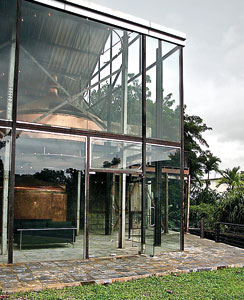In colonial times when Sri Lanka was under the rule of the British, Sir Samuel Baker founded the Ceylon Brewery in the hill country. Established in 1881 as a small brewery that catered to the European settlers, it is today known as’ Lion Brewery’.
Lion, 150 years later, is an international brand that even supplies the UK beer market. Decades after its establishment the old plant in Nuwara Eliya closed down and the Lion Brewery was moved to Biyagama. Work on the new Lion office was entrusted to Sheran Henry Associates, the architecture firm handling the project.
Architect Sheran Henry had heard that there were some beautiful old teak tables and chairs at the Nuwara Eliya plant’s main office building. What he discovered though on an initial visit was so much more than lovely antiques. There were massive copper fermentation tanks, now aged and forgotten, that had been brought down from Britain. Sadly by that time almost all had been sold by the kilo as copper.
 |
| The design centred around the old copper vessels |
The engravings read “1952 BURTON on TRENT England and Robert Morton & Co Ltd. Coppersmiths”. His team managed to save two copper fermentation vessels, a wooden cylindrical cooling unit shaped like a large tank and a series of old, solid copper beer taps, as well as the steel frames that supported one of the industrial buildings and which bore the legend “Birmingham Steel made in Great Britain”.
The tanks had to be brought down to Biyagama in large trailers on a 10 foot wide road – no easy journey with many stops through congested traffic. At Biyagama huge cranes lifted and placed the vessels on an elevated ground area within the premises and then the roof and structure were constructed around it. The whole design was literally and conceptually created centering the old copper vessels.
These beer fermentation tanks thus became the highlight of the plant and spurred the creation of the Lion Museum. The copper is about 1’ thick and the tanks are close to 15 feet in height, now polished and painted over with a protective coat of glaze. The pressure meters are still intact and so are the opening ports of the tanks, which were manually operated earlier. The structure is made to complement and highlight the vessels.
The architect also reflects the spirit of the brand through the design of the Lion Museum. “The symbol of the lion has been established as the image of the company. Lion is a strong beer. The brand ethics are matter of fact, rustic and macho. These masculine qualities are represented in the space. We wanted to build a structure with character. It’s a prominent brand. So is the design,” says the architect.
Both the exterior and the interior of the building are stark, the industrial façade almost brutal made to mimic the pragmatic factory complex in Nuwara Eliya. The front elevation is a three-storey high sheer blank wall of plastered cement with a coat of cement paint on top. The only hint of the exterior is through a glass door directly exposing the copper treasure within. The rest of the building is framed in toughened glass and steel with a steel column structure supporting steel trusses and a zinc and aluminium roof.
The steel from the original plant in Nuwara Eliya is old and corroded. Yet it is full of character, the hints of red and white paint and the rustic texture and feel of the framework [coated with a protective sealer] strangely pleasing. “In photography the beauty of an elderly person lies in the lines of experience and wisdom in their face. Likewise the old corroded steel also tells a story,” explains Sheran.
The interior is not a self- contained space. The split level hub of the museum has a display area, two small seating areas, restrooms and pantry, office, an open terrace and outer bar area inspired by the Lion pub in Nuwara Eliya. The seats are the original office chairs from the Nuwara Eliya office. The display items comprise the copper tanks, the cylindrical wooden cooling unit, the solid old beer taps and the wood and steel framework of the building, all remnants of the Ceylon Brewery plant.
In thematic design, the architect has focused on the play of contrast. There are many contrasting features within the space. The first glimpse of the exterior finds the solidity of the concrete wall against the fluidity of the glass entranceway. The contrasting use of textures and materials in the interior is also a continuation of the exterior; the hand-cut granite flooring against the shining smooth copper. The general feel of the museum heightens this theme. The harsh cold exterior is in complete contrast to the openness and warmth of the interior. There are also other noteworthy components of the space i.e. the rustic steel ‘H’ irons supporting the upper deck, the exposed machinery of the cooling unit, the wooden rafters, some of the upper level wooden flooring panels, and the cast iron factory staircase all belonging to the original design of the 1880’s.
The use of measured tension trusses from the old factory is a remarkable addition to the construction. While being valuable in terms of its history, it also functions perfectly, bearing and balancing the weight of the roof. “Today we use trusses blindly,” says Sheran. “But these tension trusses were made and used after measuring the actual tension they bear. They are very light but at the same time very strong. It’s obviously very accurate and serves its purpose well even today.”
The full splendour of the museum is best seen at night when the amber lights come on. Standing out on the grass looking in you can see the lights reflect off the copper onto the glass creating a labyrinth of reflections and lights. The ambience it creates is of old world charm taking you back in time to the days of tea and trains. |


